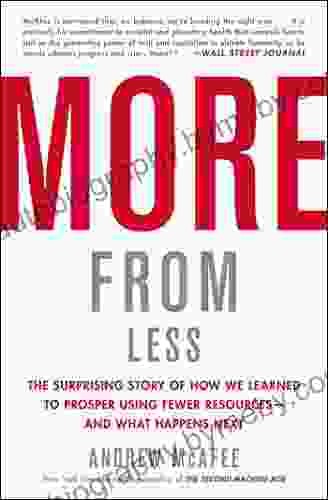The Surprising Story Of How We Learned To Prosper Using Fewer Resources And

4.3 out of 5
| Language | : | English |
| File size | : | 5168 KB |
| Text-to-Speech | : | Enabled |
| Screen Reader | : | Supported |
| Enhanced typesetting | : | Enabled |
| X-Ray | : | Enabled |
| Word Wise | : | Enabled |
| Print length | : | 351 pages |
In the not-so-distant past, it was widely believed that economic growth and prosperity were inextricably linked to the consumption of ever-increasing amounts of resources. This belief was based on the assumption that resources were finite and that, as the population grew, so too would the demand for resources. However, in recent decades, we have come to realize that this assumption is false. In fact, we have learned that it is possible to prosper using fewer resources.
This realization has led to a fundamental shift in our thinking about sustainability. In the past, sustainability was often seen as a trade-off between economic growth and environmental protection. However, we now know that sustainability is essential for both economic growth and environmental protection. By using fewer resources, we can reduce our impact on the environment and create a more sustainable future.
There are many ways to prosper using fewer resources. One way is to increase the efficiency of our resource use. This can be done by using more efficient technologies, such as energy-efficient appliances and hybrid cars. We can also reduce our consumption of resources by changing our lifestyles. For example, we can walk or bike instead of driving, and we can buy less stuff.
Another way to prosper using fewer resources is to develop new technologies that allow us to use resources more efficiently. For example, we are developing new ways to generate renewable energy, such as solar and wind power. We are also developing new ways to recycle and reuse materials.
The transition to a more sustainable future will not be easy. It will require changes in our lifestyles and in our economies. However, it is a necessary transition. By using fewer resources, we can create a more sustainable and equitable world for all.
The Benefits Of Using Fewer Resources
There are many benefits to using fewer resources. These benefits include:
- Reduced environmental impact
- Increased economic growth
- Improved social equity
- Enhanced national security
Reduced environmental impact
Using fewer resources reduces our impact on the environment. This is because we are consuming less energy, producing less waste, and emitting fewer greenhouse gases. Reducing our impact on the environment helps to protect our natural resources and ecosystems for future generations.
Increased economic growth
Using fewer resources can actually lead to increased economic growth. This is because it forces us to become more efficient and innovative. By using resources more efficiently, we can reduce our costs and become more competitive. By developing new technologies that use resources more efficiently, we can create new jobs and new industries.
**Improved social equity**
Using fewer resources can help to improve social equity. This is because it reduces the demand for resources, which can make them more affordable for everyone. It also helps to reduce pollution and other environmental problems, which can disproportionately affect low-income communities.
Enhanced national security
Using fewer resources can help to enhance national security. This is because it reduces our dependence on foreign resources. By using more domestic resources, we can become more self-sufficient and less vulnerable to supply disruptions.
The Challenges Of Using Fewer Resources
There are also some challenges to using fewer resources. These challenges include:
- Increased costs
- Reduced economic growth
- Job losses
- Social unrest
Increased costs
Using fewer resources can sometimes lead to increased costs. This is because it can require us to invest in new technologies and infrastructure. However, in the long run, using fewer resources can actually save us money. This is because it reduces our energy bills, our waste disposal costs, and our healthcare costs.
Reduced economic growth
Using fewer resources can sometimes lead to reduced economic growth. This is because it can reduce the demand for goods and services. However, this effect is usually temporary. In the long run, using fewer resources can actually lead to increased economic growth. This is because it forces us to become more efficient and innovative.
Job losses
Using fewer resources can sometimes lead to job losses. This is because it can reduce the demand for certain goods and services. However, this effect is usually temporary. In the long run, using fewer resources can actually create new jobs. This is because it creates new industries and new opportunities.
Social unrest
Using fewer resources can sometimes lead to social unrest. This is because it can lead to higher prices and job losses. However, this effect is usually temporary. In the long run, using fewer resources can actually lead to a more stable and prosperous society. This is because it reduces our dependence on foreign resources and makes us more resilient to economic shocks.
The transition to a more sustainable future will not be easy. It will require changes in our lifestyles and in our economies. However, it is a necessary transition. By using fewer resources, we can create a more sustainable and equitable world for all.
4.3 out of 5
| Language | : | English |
| File size | : | 5168 KB |
| Text-to-Speech | : | Enabled |
| Screen Reader | : | Supported |
| Enhanced typesetting | : | Enabled |
| X-Ray | : | Enabled |
| Word Wise | : | Enabled |
| Print length | : | 351 pages |
Do you want to contribute by writing guest posts on this blog?
Please contact us and send us a resume of previous articles that you have written.
 Book
Book Novel
Novel Page
Page Chapter
Chapter Text
Text Story
Story Genre
Genre Reader
Reader Library
Library Paperback
Paperback E-book
E-book Magazine
Magazine Newspaper
Newspaper Paragraph
Paragraph Sentence
Sentence Bookmark
Bookmark Shelf
Shelf Glossary
Glossary Bibliography
Bibliography Foreword
Foreword Preface
Preface Synopsis
Synopsis Annotation
Annotation Footnote
Footnote Manuscript
Manuscript Scroll
Scroll Codex
Codex Tome
Tome Bestseller
Bestseller Classics
Classics Library card
Library card Narrative
Narrative Biography
Biography Autobiography
Autobiography Memoir
Memoir Reference
Reference Encyclopedia
Encyclopedia Violet Moller
Violet Moller Phillip W Simpson
Phillip W Simpson Andy Tyson
Andy Tyson Andrew Wade
Andrew Wade Andreas Hinterhuber
Andreas Hinterhuber Ann Goodman
Ann Goodman Martijn Konings
Martijn Konings Amy Chu
Amy Chu Niqua Nakell
Niqua Nakell Samuel Hideo Yamashita
Samuel Hideo Yamashita Andy Crowe
Andy Crowe Bram Stoker
Bram Stoker Shirley Ballas
Shirley Ballas Eric Asimov
Eric Asimov Amanda M Thrasher
Amanda M Thrasher Andrew Carnegie
Andrew Carnegie Andrew Henderson
Andrew Henderson Angela Lindsey
Angela Lindsey Chou Hallegra
Chou Hallegra Ged Jenkins Omar
Ged Jenkins Omar
Light bulbAdvertise smarter! Our strategic ad space ensures maximum exposure. Reserve your spot today!

 Colin FosterUnlocking the Secrets to Healthy Conception: A Comprehensive 90-Day Guide for...
Colin FosterUnlocking the Secrets to Healthy Conception: A Comprehensive 90-Day Guide for... Seth HayesFollow ·4.6k
Seth HayesFollow ·4.6k Raymond ParkerFollow ·19.3k
Raymond ParkerFollow ·19.3k Gary CoxFollow ·10.8k
Gary CoxFollow ·10.8k Gilbert CoxFollow ·10.2k
Gilbert CoxFollow ·10.2k Mitch FosterFollow ·16.7k
Mitch FosterFollow ·16.7k Neil ParkerFollow ·12.6k
Neil ParkerFollow ·12.6k Vic ParkerFollow ·14.2k
Vic ParkerFollow ·14.2k Dan BellFollow ·12.8k
Dan BellFollow ·12.8k

 Bryce Foster
Bryce FosterCelebrate the Luck of the Irish: Unveiling Saint...
As the verdant hues of spring brush...

 Chase Simmons
Chase SimmonsCody Rodeo: A Photographic Journey into the Heart of the...
Step into the arena of the...

 David Mitchell
David MitchellUnveiling the Enchanting World of Door County Quilts: A...
Step into the Heart of Amish Country in...

 Floyd Powell
Floyd PowellCowboy Chatter: Unraveling the Enigmatic Tales of the Old...
Step into the...

 Ismael Hayes
Ismael HayesUnlock Content Marketing Mastery: How to Create...
In today's digital landscape, content is...

 Boris Pasternak
Boris PasternakMore Than 200 Hardball Questions For The Thinking Fan
The Ultimate Baseball Trivia Challenge Are...
4.3 out of 5
| Language | : | English |
| File size | : | 5168 KB |
| Text-to-Speech | : | Enabled |
| Screen Reader | : | Supported |
| Enhanced typesetting | : | Enabled |
| X-Ray | : | Enabled |
| Word Wise | : | Enabled |
| Print length | : | 351 pages |









